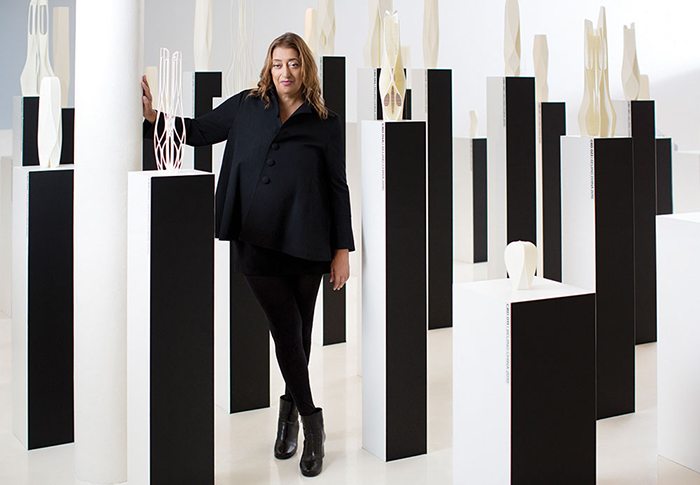Profile
Zaha Hadid, founder of Zaha Hadid Architects, was awarded the Pritzker Architecture Prize (considered to be the Nobel Prize of architecture) in 2004 and is internationally known for both her theoretical and academic work. Each of her dynamic and innovative projects builds on over thirty years of revolutionary exploration and research in the interrelated fields of urbanism, architecture and design.
Hadid’s interest lies in the rigorous interface between architecture, landscape and geology as her practice integrates natural topography and human-made systems, leading to experimentation with cutting-edge technologies. Such a process often results in unexpected and dynamic architectural forms.
Education
Hadid studied architecture at the Architectural Association from 1972 and was awarded the Diploma Prize in 1977.
Teaching
She became a partner of the Office for Metropolitan Architecture, taught at the AA with OMA collaborators Rem Koolhaas and Elia Zenghelis, and later led her own studio at the AA until 1987.
Since then she has held the Kenzo Tange Chair at the Graduate School of Design, Harvard University; the Sullivan Chair at the University of Illinois, School of Architecture, Chicago; guest professorships at the Hochschule für Bildende Künste in Hamburg; the Knolton School of Architecture, Ohio and the Masters Studio at Columbia University, New York.
In addition, she was made Honorary Member of the American Academy of Arts and Letters, Fellow of the American Institute of Architecture and Commander of the British Empire, 2002. She is currently Professor at the University of Applied Arts in Vienna, Austria and was the Eero Saarinen Visiting Professor of Architectural Design at Yale University, New Haven, Connecticut.
Awards
Zaha Hadid’s work of the past 30 years was the subject of critically-acclaimed retrospective exhibitions at New York’s Solomon R. Guggenheim Museum in 2006, London’s Design Museum in 2007 and the Palazzo della Ragione, Padua, Italy in 2009. Her recently completed projects include the MAXXI Museum in Rome; which won the Stirling award in 2010. Hadid’s outstanding contribution to the architectural profession continues to be acknowledged by the most world’s most respected institutions.
She received the prestigious ‘Praemium Imperiale’ from the Japan Art Association in 2009, and in 2010, the Stirling Prize – one of architecture’s highest accolades – from the Royal Institute of British Architects. Other recent awards include UNESCO naming Hadid as an ‘Artist for Peace’ at a ceremony in their Paris headquarters last year.
Also in 2010, the Republic of France named Hadid as ‘Commandeur de l’Ordre des Arts et des Lettres’ in recognition of her services to architecture, and TIME magazine included her in their 2010 list of the ‘100 Most Influential People in the World’.
This year’s ‘Time 100’ is divided into four categories: Leaders, Thinkers, Artists and Heroes – with Hadid ranking top of the Thinkers category.
ZHA projects
Zaha has played a pivotal role in a great many Zaha Hadid Architects projects over the past 30 years. The MAXXI: National Museum of 21st Century Arts in Rome, Italy; the BMW Central Building in Leipzig, Germany and the Phaeno Science Center in Wolfsburg, Germany are excellent demonstrations of Hadid’s quest for complex, fluid space.
Previous seminal buildings such as the Rosenthal Center for Contemporary Art in Cincinnati, USA, have also been hailed as architecture that transforms our vision of the future with new spatial concepts and bold, visionary forms.
Currently Hadid is working on a multitude of projects worldwide including: the London Aquatics Centre for the 2012 Olympic Games; High-Speed Train Stations in Naples and Durango; the CMA CGM Headquarters tower in Marseille; the Fiera di Milano masterplan and tower as well as major master-planning projects in Beijing, Bilbao, Istanbul and Singapore. In the Middle East, Hadid’s portfolio includes national cultural and research centres in Jordan, Morocco, Algeria, Azerbaijan, Abu Dhabi and Saudi Arabia, as well as the new Central Bank of Iraq.

